Block Copolymers and Hybrid Materials
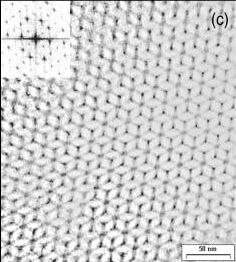 A block copolymer joins together chains (blocks) of different types of monomer (eg. A-A-A-A-A-B-B-B-B-B) that would not ordinarily mix. Because the covalent linkages prevents bulk demixing, the blocks can only microphase separate into domains of the size of the individual polymers (5-100nm). These domains can in turn self-assemble into crystalline arrangements of balls, rods, sheets, helices, rings, network labyrinths and ever more exotic things (see Physics Today, February 1999 - Bates and Fredrickson).
A block copolymer joins together chains (blocks) of different types of monomer (eg. A-A-A-A-A-B-B-B-B-B) that would not ordinarily mix. Because the covalent linkages prevents bulk demixing, the blocks can only microphase separate into domains of the size of the individual polymers (5-100nm). These domains can in turn self-assemble into crystalline arrangements of balls, rods, sheets, helices, rings, network labyrinths and ever more exotic things (see Physics Today, February 1999 - Bates and Fredrickson).
As well as pure polymer applications (eg. SBS copolymer in shoes and car tires), copolymers can direct the structure of other materials at the nanometer scale. The ceramic shown in the image has a 3-D labyrinth of 10nm pores formed via the self-assembly of a silica/copolymer mixture. Materials structured at the nanometer scale have many applications (eg. high area catalysts and selective membranes) and many groups at Cornell are collaborating in this area.
- CCMR IRG4 - Nano- and Mesoscale Controlled Macromolecular Assemblies
- Cornell Fuel Cell Institute
- Ober Research Group
- Wiesner Research Group
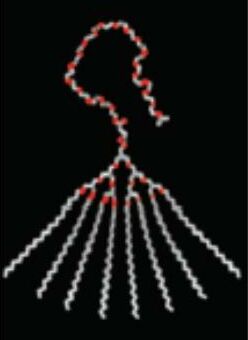 Dendrimer Copolymers :
Introducing branches in a homopolymer can markedly change it's molecular shape. This change in shape has a profound effect on its behaviour in a block copolymer. Not only do dendrimers have new morphologies not seen in linear block copolymers, but a single dendrimer can assume several different morphologies depending only on the temperature.
Dendrimer Copolymers :
Introducing branches in a homopolymer can markedly change it's molecular shape. This change in shape has a profound effect on its behaviour in a block copolymer. Not only do dendrimers have new morphologies not seen in linear block copolymers, but a single dendrimer can assume several different morphologies depending only on the temperature.
[1] B.K. Cho et. al. Generation dependent mesophase behavior in extended amphiphilic dendrons in the shape of macromolecular dumbbells. Chem. Comm. 2005, 2005, 2143-2145. [.pdf 182 Kb]
[2] B.K. Cho, et. al. Mesophase Structure-Mechanical and Ionic Transport Correlations in Extended Amphiphilic Dendrons. Science 305, 2004, 1598-1601, 1527 [.pdf 191 kB Review: B. Halford. Chem & Eng. News, 82, 9-10 (.pdf 124 kb)]
[3] B.K. Cho, et. al. Synthesis and Self-Assembly of Amphiphilic Dendrimers Based on Aliphatic Polyether-Type Dendritic Cores. Macromolecules, 37, 2004, 4227-4234. [.pdf 151 kB ]
[4] B.K. Cho, et. al. Nanohybrids from Liquid Crystalline Extended Amphiphilic Dendrimers. J. Am. Chem. Soc., 126, 2004, 4070-4071 [.pdf 132 kB ]
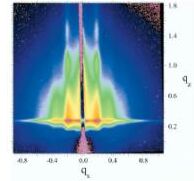 GISAXS on Films :
Thin films of block copolymers can be used to change a material's surface properties. Copolymers have also been proposed as a way to achieve "bottom-up" lithography by patterning their domain structure onto the material beneath. Grazing Incidence Small Angle X-ray scattering can see film structure both at the surface and all the way into the film, simply by adjusting the angle between the incoming X-rays and the substrate. We're using GISAXS at CHESS to study a wide range of surface coatings.
GISAXS on Films :
Thin films of block copolymers can be used to change a material's surface properties. Copolymers have also been proposed as a way to achieve "bottom-up" lithography by patterning their domain structure onto the material beneath. Grazing Incidence Small Angle X-ray scattering can see film structure both at the surface and all the way into the film, simply by adjusting the angle between the incoming X-rays and the substrate. We're using GISAXS at CHESS to study a wide range of surface coatings.
[1] P Du et. al. Additive-Driven Phase-Selective Chemistry in Block Copolymer Thin Films; The Convergence of Top-Down and Bottom-Up Approaches. Advanced Materials, 16, 2004, 953-957 [.pdf 501 Kb]
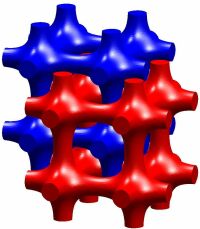 Network Structures:
For a narrow set of conditions, linear diblock copolymers form a continuous 3-D network of branching rods. The network of rods is a compromise between flat 2-D sheets and the curvature of 1-D cylinders. Because these networks are continuous throughout space such a morphology is ideal for porous materials. In collaboration with the Wiesner group, we confirmed block copolymers could direct aluminosilica to assemble into network structures.
Network Structures:
For a narrow set of conditions, linear diblock copolymers form a continuous 3-D network of branching rods. The network of rods is a compromise between flat 2-D sheets and the curvature of 1-D cylinders. Because these networks are continuous throughout space such a morphology is ideal for porous materials. In collaboration with the Wiesner group, we confirmed block copolymers could direct aluminosilica to assemble into network structures.
[1] A Jain et. al. Direct Access to Bicontinuous Skeletal Inorganic Plumber's Nightmare Networks from Block Copolymers. Angew. Chem. Int. Ed. 44, 2005, 1226–1229 305. [.pdf 230 Kb]
[2] A.C. Finnefrock, et. al. (2001). Metal-containing mesoporous silica with bicontinuous plumber’s nightmare morphology from a block copolymer-hybrid mesophase. Angewandte Chemie, 40,:1208-1211. [.pdf 1.1 Mb]
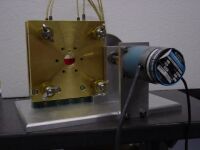 Alignment and Shear:
Processing inevitably exposes polymers to shear fields and these can align the internal structure of block copolymers. To study these effects we constructed a cell in which the effects of shear could be studied in situ via X-ray scattering. As part of his senior thesis, Gideon Alon commissioned the shear cell and studied alignment effects on lamellar domains.
Alignment and Shear:
Processing inevitably exposes polymers to shear fields and these can align the internal structure of block copolymers. To study these effects we constructed a cell in which the effects of shear could be studied in situ via X-ray scattering. As part of his senior thesis, Gideon Alon commissioned the shear cell and studied alignment effects on lamellar domains.
[1] A Jain, et. al. Flow-Induced Alignment of Block Copolymer-Sol Nanoparticle Coassemblies toward Oriented Bulk Polymer-Silica Hybrids. Macromolecules 2005, 38, 10095-10100. [.pdf 437 Kb]
[2] A. Jain, et. al. Effect of Filler Dimentionality of the Order Disorder Transition of a Model Block Copolymer Nanocomposite. Macromolecules, 35, 2002, 4862-4865. [.pdf 112 Kb]
 New Structures and Materials:
In collaboration with the Wiesner group, we're studying new types of copolymer-ceramic hybrid materials. For example, methacrylates are compatible with epoxides leading to new potential applications for methacrylate coated particles. Recently we've been investigating ABC triblock copolymers and ABC-hybrid materials.
New Structures and Materials:
In collaboration with the Wiesner group, we're studying new types of copolymer-ceramic hybrid materials. For example, methacrylates are compatible with epoxides leading to new potential applications for methacrylate coated particles. Recently we've been investigating ABC triblock copolymers and ABC-hybrid materials.
[1] S. Mahajan et. al. Synthesis and Characterization of Amphiphilic Poly(ethylene oxide)-block-poly(hexyl methacrylate) Copolymers. Macromol. Chem. Phys., 204, 2003, 1047–1055 [.pdf 223 Kb]
[2] S. Renker et. al. Nanostructure and Shape Control in Polymer-Ceramic Hybrids from Poly(ethylene oxide)-block-Poly(hexyl methacrylate) and Aluminosilicates Derived from Them. Macromol. Chem. Phys., 205, 2004, 1021–1030. [.pdf 383 Kb]